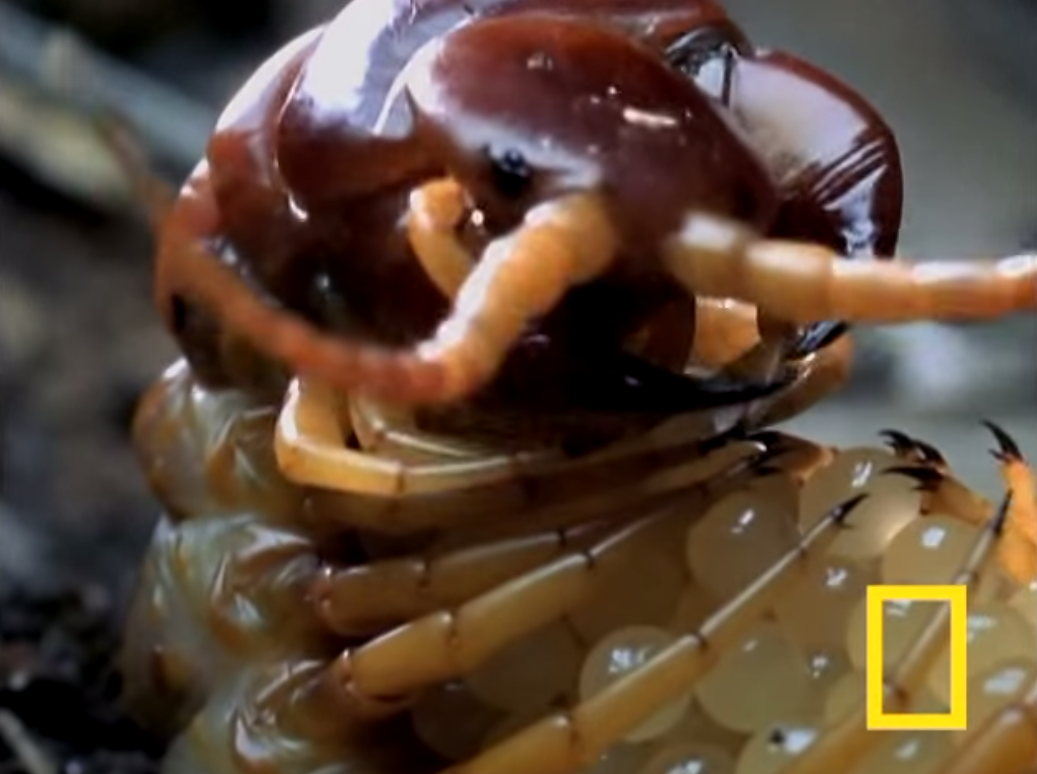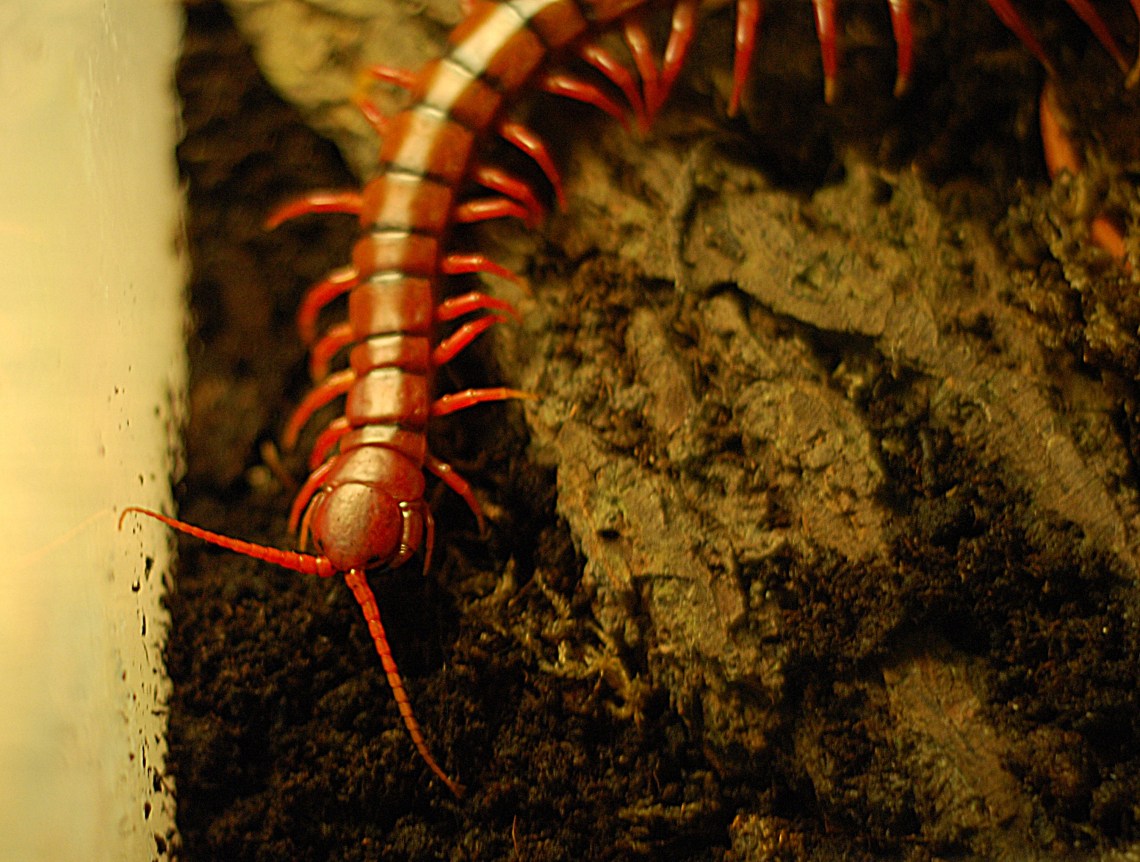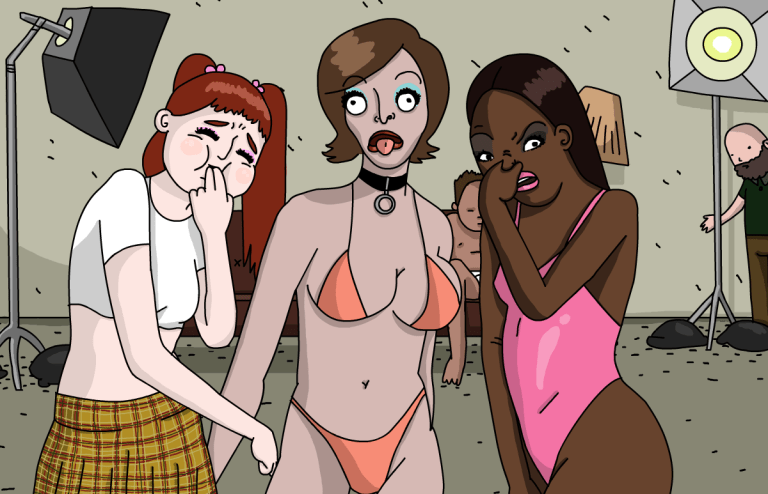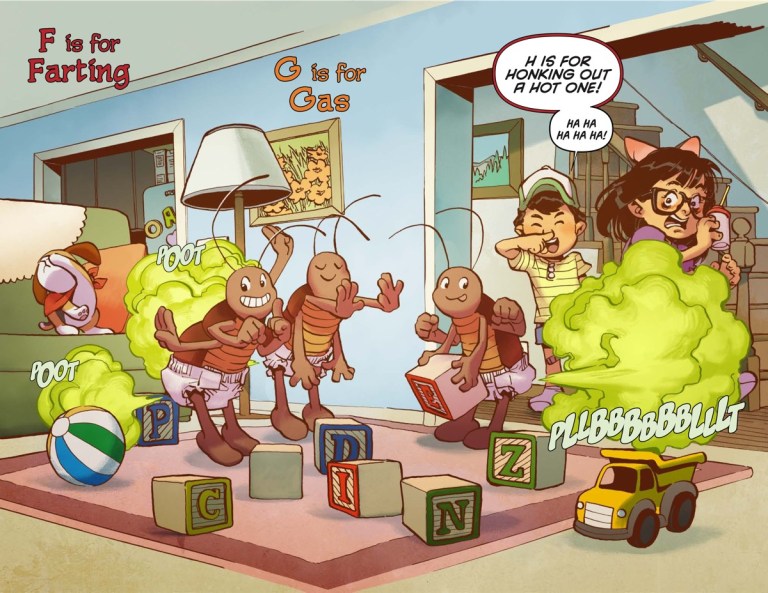The Anatomy Of Disgust: “Creeping Things That Creep Upon The Earth”
To me, centipedes are a means to a philosophical end: anatomizing the emotion of disgust.
By Mark Dery


To Greg Edgecombe, a paleontologist at the Natural History Museum in London, centipedes are a way of thinking about evolutionary biology. The number of trunk segments to which each pair of legs is attached has changed over time and often differs within species based on variables such as geographic distribution—a distinguishing characteristic that can be used to trace evolutionary development.
To me, centipedes are a means to a philosophical end: anatomizing the emotion of disgust.
Immediately, things get complicated: is disgust, in fact, an emotion? Or is it a gut reaction? Or both? Taking its cue from the word’s etymological roots in the 16th-century French desgoust (“distaste”), the Oxford English Dictionary thinks disgust is a “strong distaste or disrelish for food in general, or for any particular kind or dish of food,” though the dictionary hedges its bets, offering the alternate definition of “nausea, loathing.”i Well, which is it—a physiological response (nausea) or a powerful emotion (loathing)?
Of course, distaste or disrelish are rarely pure reflex when it comes to food; taste and taboo are “No Trespassing” signs on the border between us and Other, the refined and the rude, civilization and savagery. One man’s retchingly vile puddle of putrescence is another man’s casu marzu, the Sardinian delicacy created by allowing sheep’s-milk cheese to rot into near-deliquescence, then letting the larvae of the cheese fly (Piophila casei) finish the job. More accurately, it’s their digestive acids that make the magic happen: the larvae eat the cheese, then excrete it; the gooey, malodorous results are casu marzu—maggot waste, by any other name.ii Wriggling with larvae and oozing a purulent discharge the locals euphemize as lagrima (“tears”), the cheese is served to delighted aficionados, who must also be vigilant aficionados, quick with the swatting hand or the flicked napkin, since cheese-fly maggots are capable of leaping up to six inches when disturbed—and, really, what’s more disturbing than being eaten alive? Reportedly, they aim for the eyes. If you do get the better of them, choking them down along with a tongue-blistering mouthful of the acrid, ammoniac cheese, your victory may be short-lived: if the larvae escape your stomach acids unscathed, they could, it is rumored, attempt to gnaw through your intestinal wall, causing vomiting, bloody diarrhea, and what lawyers like to call mental anguish.
Disgust, it seems, is a paradoxical thing. Its raw, visceral nature makes it seem more deeply Darwinian than any other emotion, less a conscious reaction than a product of evolutionary programming, like the fight-or-flight response. Fear and anger can hide behind iron-jawed stoicism or the bright-smiling guile of the sociopath, but disgust will not be repressed. Like vomiting (with which it is closely associated), it overwhelms our civilized selves, returning us to the infantile phase, perhaps to our simian origins; disgust’s native language is the babyish and the bestial: the curled lip of repulsion, the full-body shudder, the finger-down-the-throat pantomime of puking that is the universal sign, among American teens, for things that make us go ewwwww. Yet, for all that, digust is equally a product of nurture, as casu marzu makes clear.
[youtube https://www.youtube.com/watch?v=euCOwp0LMDY%5D
The OED suggests as much. In its second pass at a definition, it calls disgust a “strong repugnance, aversion, or repulsion excited by that which is loathsome or offensive, as a foul smell, disagreeable person or action, disappointed ambition, etc.”iii But this definition, too, runs afoul of disgust’s double nature, its essential uncanniness. Playing fast and loose with the senses and sensibility (a “foul smell” is in a different category altogether from a “disagreeable person or action”); modulating abruptly between the gag reflex prompted by “that which is loathsome” and the moral outrage provoked by the “offensive,” this alternate definition can’t decide if disgust is an evolutionary response, as the phrase “instinctive dislike” suggests, or a visceral expression of moral disapproval—rising bile in the angels of our better natures.iv
William Ian Miller, in The Anatomy of Disgust, considers the phenomenon through the lenses of moral psychology, social relations, and aesthetics. Miller’s disgust enforces hierarchies: it polices class divisions, draws a racist line between Us and Them, marks off the xenophobic divide between native-born and alien. But in its desperate attempt to patrol the borders between black-or-white binaries, disgust betrays our anxious awareness that some of the truths we regard as self-evident are disconcertingly relative, the flimsy ideological props of a specific social order at a given historical moment.
Miller traces the “modern psychological interest in disgust”— disgust studies, let’s call it—to Darwin, in The Expression of the Emotions in Man and Animals.v Like the OED, Darwin locates its origins in the sense of taste, and in things that offend the palate. He’s quick to note the cultural relativism of disgust: the Tierra del Fuego native who pokes the cold preserved meat Darwin is having for dinner registers “utter disgust at its softness” while Darwin, for his part, feels “utter disgust at my food being touched by a naked savage, though his hands did not appear dirty.”vi Both his disgust and the native’s, he decides, are the product of “the strong association in our minds between the sight of food, however circumstanced, and the idea of eating it.”vii This, it occurs to him, is why “a smear of soup on a man’s beard looks disgusting, though there is of course nothing disgusting in the soup itself.”

Miller doesn’t deny that disgust involves taste, not to mention the other senses (such as touch, in the native’s case, and sight in Darwin’s), and he concedes that it’s “the most embodied and visceral of emotions”; nonetheless, he insists, it is above all else “a moral and social sentiment”: “It plays a motivating and confirming role in moral judgment… It ranks people and things in a kind of cosmic ordering.”viii Miller’s disgust is “a complex sentiment” that has at its heart “a strong sense of aversion to something perceived as dangerous because of its powers to contaminate, infect, or pollute by proximity, contact, or ingestion.”ix Food is often a source of disgust because it’s so profoundly a part of who we are, culturally, socially, ethnically, and racially; we are, after all, what we eat. The cold preserved meat on another man’s plate is never just that; it’s a symbol, too, and a multilayered one at that, rich in meaning. Miller uses the parable of Darwin and the Naked Savage to underscore the point that disgust, more often than not, is as much social construction as gut reaction: Darwin is appalled at the thought of the native touching his food, not because the man’s hands are dirty (in fact, they’re not, as Darwin concedes), but because he is a “naked savage” whose taboo-violating wildness is so threatening to the established order that “Darwin fears ingesting some essence of savagery that has been magically imparted to his food by the finger of the naked savage”; the native, from his side of the looking-glass, regards Darwin as no less barbarous, chowing down on a cold, squishy abomination no civilized man would put in his mouth.x It is, says Miller, a “battle of competing disgusts” whose stakes are cultural dominance and conflicting social orders.
Likewise, Darwin’s disgust at the imagined smear of soup on a man’s beard is not disgust at the thought of eating it, as the doggedly etymological definition of disgust insists, since no one in his right mind would suck the soup out of a man’s beard. (Then again, as Internet Rule 34 reminds us, “If something exists, there is porn of it”; who knows what paraphilias lurk on the far fringes of fetishism?) For Miller, a daub of gunk in a beard isn’t irreducibly disgusting because, well, disgusting things are self-evidently disgusting; it has a moral valence, too.
The soup on the beard reveals the man as already contaminated by a character defect, a moral failure in keeping himself presentable in accordance with the righteously presented demand that he maintain his public purity and cleanliness of person and not endanger us by his incompetence. … It is thus not our fear of oral incorporation that makes the soup disgusting to us but his failure to have properly orally incorporated it.xi

Even so, a “strong distaste or disrelish…for any particular kind or dish of food,” to quote the OED, isn’t always an objective correlative to cultural contempt or moral horror. Casu marzu notwithstanding, we shrink from rotten food and unclean or venomous creatures because revulsion, according to Rachel Herz, a research psychologist, is intuition warning us away from things that, if eaten, could make us sick or kill us. Disgust, she postulates, in That’s Disgusting: Unraveling the Mysteries of Repulsion, “evolved uniquely in humans from the emotion of fear, to help us confront our number one predator, pathogens.”xii Herz draws on Paul Rozin’s concept of a “core disgust”—a prototype of all disgusts, all the way up to Miller’s “moral and social sentiment”—that is oral in origin. Rozin, an experimental psychologist, was the first researcher to take disgust seriously. (Herz calls him “the father of disgust in psychology.”xiii) In the 1980s, he theorized that taste is the sense that triggers the emotion, the mouth is the stage where the drama of disgust is played out, and incorporation or rejection (spitting out, throwing up) are its quintessential expressions.xiv Rozin’s disgust is cognitively sophisticated, not some primitive gut instinct. Driven by fears of contamination and contagion, it operates according to the principles of sympathetic magic: things that look alike must be similar not just in appearance but in substance, too; once something touches something disgusting, it is ineradicably tainted by it. (Rozin’s experiments, which betray a deliciously perverse sense of humor, reveal the ubiquity, and the tenacity, of such beliefs: toddlers refused to eat the convincingly realistic dog feces he sculpted out of peanut butter and foul-smelling cheese;xv 69 percent of adult men and women refused to put a brand-new tampon into their mouths, even though it was unwrapped in front of them.xvi)
Updating for the age of evolutionary psychology and neuroscience Rozin’s theory that “our response to bitter taste is the sensory origin of the emotion of disgust, and all our other disgusts are built upon it,”xvii Herz locates disgust’s home address in the basal ganglia, four interconnected structures at the base of the cerebrum, and in a part of the temporal lobe called the insula, “a raunchy, devilish brain region…responsible for self-indulgence, sensual pleasure, and the temptations of addiction.”xviii The insula plays an instrumental role in the neurochemistry of disgust: brain-imaging studies have revealed that it lights up when healthy adults are shown pictures of overflowing toilets or asked to think about eating cockroaches. People with Huntington’s disease, which affects both the basal ganglia and the insula, are unable to read facial expressions registering disgust; have difficulty recognizing what the sounds of retching indicate; and have no idea what emotion the sight of cockroaches or mutilated bodies stirs in most people.xix

image – Flickr / Bill & Mark Bell
Both Miller’s social-constructionist assertion that disgust is tied to moral judgment and social control, and Herz’s argument, from evolutionary psychology and neuroscience, that what began as a biological alarm, warning us of the presence of pathogens, now warns us, as well, of magical contaminants—things that violate social taboos or offend our morals—ring true. When I see a reeking heap of dog logs plopped in the middle of the sidewalk, I’m disgusted in the Millerian sense, at the selfishness of an owner who’d let his pet take a dump on the social contract, and in the Herzian sense, at how close I came to stepping in it and being contaminated by its crawling horror.

image – Flickr / Chris Zielecki
But does either theory really explain the universal disgust inspired by centipedes? Granting Herz’s (and Rozin’s) premise that all disgust, no matter how abstracted, can be traced back to our spontaneous revulsion at the thought of putting tainted or poisonous things into our mouths, the universal fear and loathing of Chilopoda (the class of Myriapoda comprising the centipedes) makes perfect sense. Every species of centipede is venomous; as a result, virtually all the world’s food cultures give them a wide berth (with the exception of Vietnam and China, where according to Edgecombe you can try Scolopendra subspinipes mutilans, deep-fried, on a stick, if you must). “The most omnivorous of all animals, [man] has spared few of the creatures which share his planet but seems to have made an exception of the centipede,” writes R.F. Lawrence in The Centipedes and Millipedes of Southern Africa.

Few tribes or peoples, however primitive and however hard pressed by food scarcity, seem able to overcome a natural repugnance for poisonous animals, such as centipedes and scorpions, so that they are seldom used for food. In Siam, it is true, centipedes are roasted and given to children suffering from ‘thinness and swollen belly’ and it is said that under the excitements of religious fanaticism African Arabs swallow them alive together with prickly pear leaves, pieces of glass, and other unpleasant objects.xx As a rule, however, these animals inspire a certain healthy prejudice in most people…xxi
As for Miller’s moral and social disgust, which enforces hierarchy, ranking “people and things in a kind of cosmic ordering,” the centipede’s lowly state, in the literal sense of crawling on the ground, translates in the human scheme of things into a lowly social status. Dead last in the Great Chain of Being, insects are the ultimate underclass, so untouchably loathsome that their pariahdom is catching.1 “Whatsoever goeth upon the belly, and whatsoever goeth upon all four, or whatsoever hath more feet among all creeping things that creep upon the earth [italics mine], them ye shall not eat; for they are an abomination,” Leviticus decrees, and having decreed can’t resist troweling it on, adding, in case any clarification was needed, “Ye shall not make yourselves abominable with any creeping thing that creepeth, neither shall ye make yourselves unclean with them, that ye should be defiled thereby.”xxii Behind the ancient lawgiver’s understandable prohibition against eating poisonous things lurks a more Millerian disgust, one that conflates the literally lowly (i.e., creeping upon the earth) with the morally abominable. The centipede gives shape to a baseness so supernaturally vile that, following Rozin’s laws of magical contagion, it defiles everything it touches—forever. ![]()
[youtube https://www.youtube.com/watch?v=TzF0GKfOvRY%5D
Footnotes
1# Centipedes aren’t insects, of course, although both belong to classes—Chilopoda and Insecta, respectively—that along with Arachnida (spiders, scorpions, mites, ticks) and Malacostraca (shrimp, lobsters, crabs, et. al.), among others, are crowded into the big tent of Arthropoda, the invertebrate phylum whose members have exoskeletons, segmented bodies, and jointed appendages. That said, I will, from time to time, cite popular attitudes toward insects as if they applied equally to centipedes for the simple reason that, in matters of disgust, they do: most people, confronted by a foot-long, fast-moving Scolopendromorph, do not scruple at taxa.
Endnotes
i# “Disgust,” n. OED Online. Oxford University Press, March 2014. Web. Accessed May 07, 2014.
ii# Rachel Herz, That’s Disgusting: Unraveling the Mysteries of Repulsion (New York: W. W. Norton & Company, 2012), 5-6.
iii# “Disgust,” OED Online, ibid.
iv# “Disgust,” OED Online, ibid.
v# William Ian Miller, The Anatomy of Disgust (Cambridge, MA: The Harvard University Press, 1997), 1.
vi# Miller, The Anatomy of Disgust, ibid.
vii# Quoted in Miller, The Anatomy of Disgust, ibid.
viii# Miller, The Anatomy of Disgust, 2.
ix# Miller, The Anatomy of Disgust, ibid.
x# Miller, The Anatomy of Disgust, 3.
xi# Miller, The Anatomy of Disgust, 4.
xii# Rachel Herz, That’s Disgusting: Unraveling the Mysteries of Repulsion, 82.
xiii# Herz, That’s Disgusting, ix.
xiv# I rely, here, on Miller’s synopsis of Rozin’s ideas in The Anatomy of Disgust, 6-7.
xv# Miller, The Anatomy of Disgust, 258, note 16.
xvi# Herz, That’s Disgusting, 173.
xvii# Herz, ibid., 30.
xviii# Herz, ibid., 64.
xix# My discussion of the neurology of disgust is based on Herz, ibid., 61-66.
xx# Lawrence’s “African Arabs” in thrall to “religious fanaticism” sound a lot like the Sufi brotherhoods described by Paul Bowles in Their Heads Are Green and Their Hands Are Blue, his account of traveling around Morocco, in 1959, recording representative examples of the country’s musical traditions for the Library of Congress LP, Music of Morocco. Bowles witnessed members of these cults, which go by such names as the Aissaoua and the Jilala, dancing themselves into a state of frenzied ecstasy. Possessed by the crisscrossing, ever-accelerating rhythms of Berber music, they enter into a trance; on such occasions, writes Bowles, adepts often give themselves over to “self-torture,” specifically “ordeal by fire and the sword, and the eating of broken glass and scorpions.” It doesn’t strain the imagination to suppose that, if scorpions were in short supply, a centipede would do. (Paul Bowles, Their Heads Are Green and Their Hands Are Blue:




